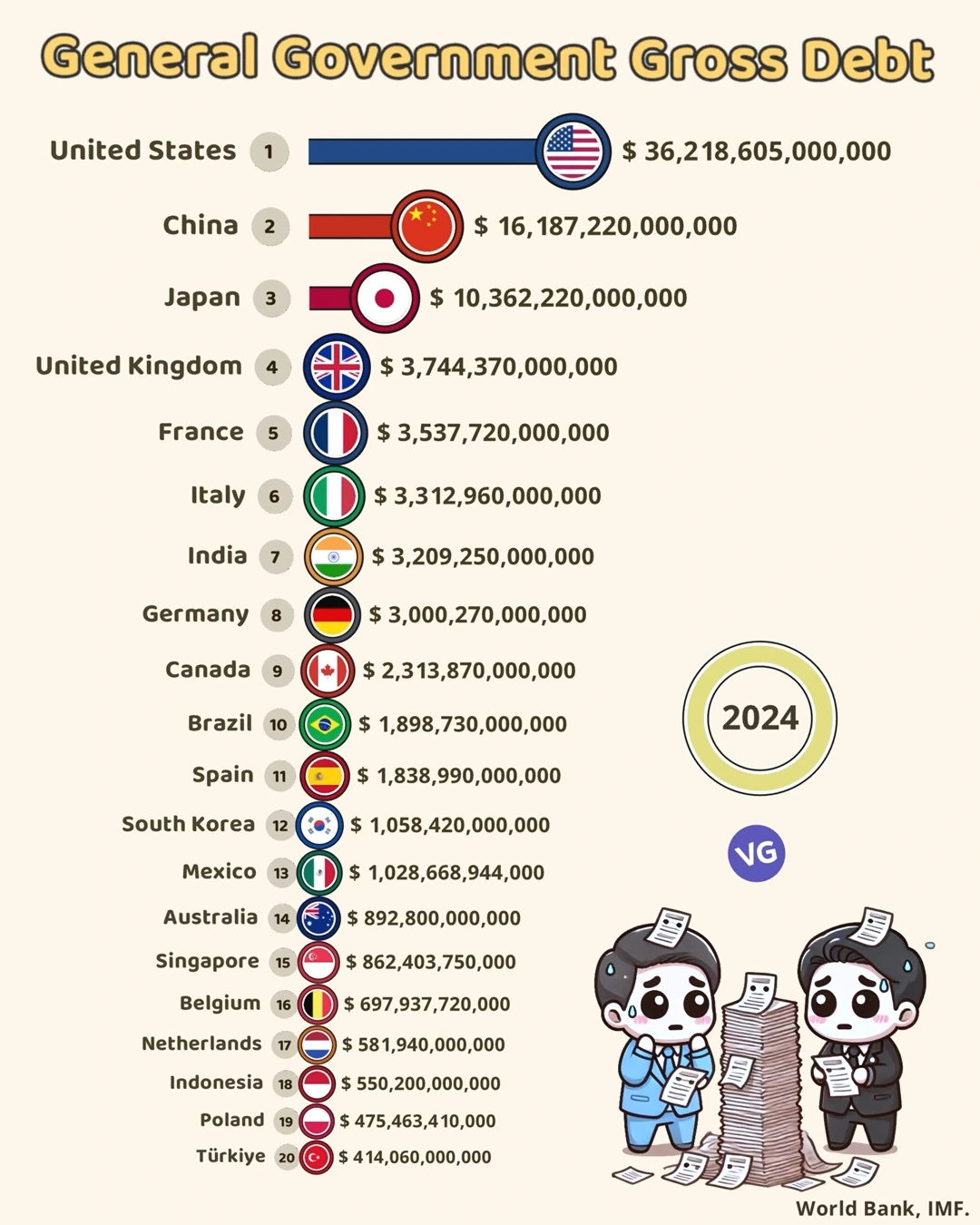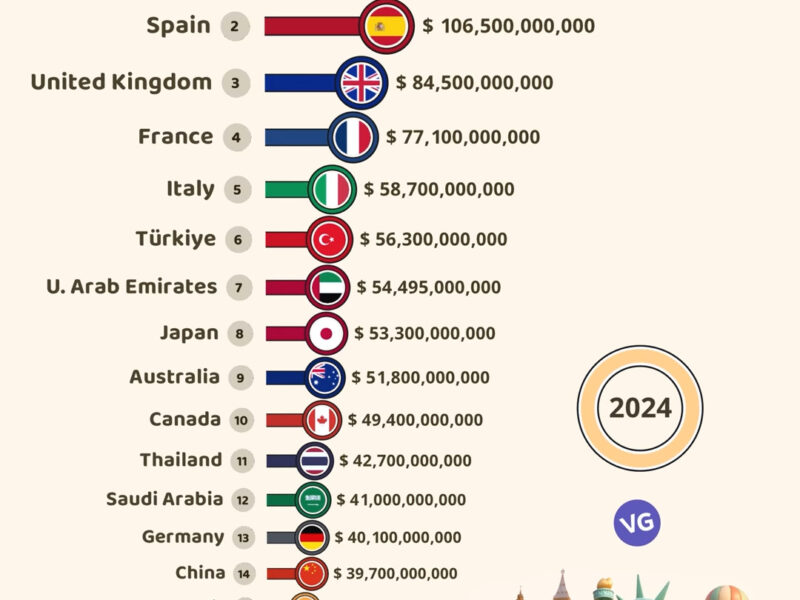In 2023, developing nations spent $1.4 trillion on foreign debt. This shows the big economic problems they face. As we move into 2024, the world’s public debt is expected to hit a scary $102 trillion.
This increase is due to many things. Like aging populations, higher healthcare costs, and ongoing debt crises. The International Monetary Fund (IMF) says the debt-to-GDP ratio has grown a lot since 2022. This makes people worry about public debt levels.
The Most Indebted Countries in the World 2024
| Rank | Country | Gross Debt (USD) | Flag |
|---|---|---|---|
| 1 | United States | $36,218,605,000,000 | 🇺🇸 |
| 2 | China | $16,187,220,000,000 | 🇨🇳 |
| 3 | Japan | $10,362,220,000,000 | 🇯🇵 |
| 4 | United Kingdom | $3,744,370,000,000 | 🇬🇧 |
| 5 | France | $3,537,720,000,000 | 🇫🇷 |
| 6 | Italy | $3,312,960,000,000 | 🇮🇹 |
| 7 | India | $3,209,250,000,000 | 🇮🇳 |
| 8 | Germany | $3,000,270,000,000 | 🇩🇪 |
| 9 | Canada | $2,313,870,000,000 | 🇨🇦 |
| 10 | Brazil | $1,898,730,000,000 | 🇧🇷 |
| 11 | Spain | $1,838,990,000,000 | 🇪🇸 |
| 12 | South Korea | $1,058,420,000,000 | 🇰🇷 |
| 13 | Mexico | $1,028,668,944,000 | 🇲🇽 |
| 14 | Australia | $892,800,000,000 | 🇦🇺 |
| 15 | Singapore | $862,403,750,000 | 🇸🇬 |
| 16 | Belgium | $697,937,720,000 | 🇧🇪 |
| 17 | Netherlands | $581,940,000,000 | 🇳🇱 |
| 18 | Indonesia | $550,200,000,000 | 🇮🇩 |
| 19 | Poland | $475,463,410,000 | 🇵🇱 |
| 20 | Türkiye | $414,060,000,000 | 🇹🇷 |
This article will look at the countries with the most debt in 2024. We’ll see how this high debt affects their already struggling economies.
Global Public Debt Overview
Understanding global public debt is key to knowing economic stability and fiscal policies worldwide. By 2023, global government debt hit a record high of $315 trillion. This is about 333% of global GDP, showing big economic challenges for both rich and poor countries.
Current Debt Levels and GDP Ratios
Low- and middle-income countries (LMICs) saw their external debt jump to $8.8 trillion in 2023. This rise in debt also means higher costs for debt servicing. The share of debt service in GNI is putting a lot of pressure on these countries, making it hard for them to grow and recover.
| Region | External Debt (Trillions USD) | Debt Service as % of GNI |
|---|---|---|
| Low- and Middle-Income Countries | 8.8 | Rising Significantly |
| Emerging Markets | 105+ | Under Pressure |
| Mature Markets | 63.0 | Increased Burden |
Key Contributors to Rising Debt
Many factors contribute to rising debt levels. The U.S. and China are major players, with the U.S. making up 34.6% of global debt. Aging populations and higher healthcare costs add to the fiscal burden. Emerging markets are now relying more on the IMF and World Bank, seen in the pandemic’s impact on their debt.
LMICs are hit hard by variable-rate long-term debt due to higher global interest rates. They face economic challenges and debt distress. Risks from armed conflicts, trade issues, and slow growth in big economies like China are also concerns.
The Most Indebted Countries in the World 2024
In 2024, the world’s economy shows a big problem for the top 10 most indebted countries. They all face huge sovereign debt burdens. The global public debt is expected to hit $102 trillion, up by $5 trillion from last year.
Countries like the United States, China, and Japan are at the top of this list. Each country has its own economic challenges. These challenges come from different factors that cause their debt to grow.
Top 10 Countries by Gross Debt
| Rank | Country | Gross Debt (in Billion $) | Debt-to-GDP Ratio (%) | Global Debt Share (%) |
|---|---|---|---|---|
| 1 | United States | 35,293 | 121.0 | 34.6 |
| 2 | China | 16,464.3 | 90.1 | 16.1 |
| 3 | Japan | 10,224.1 | 251.2 | 10.0 |
| 4 | United Kingdom | 3,652.1 | 101.8 | 3.6 |
| 5 | France | 3,564.5 | 112.3 | 3.5 |
| 6 | Italy | 3,253.4 | 136.9 | 3.2 |
| 7 | India | 3,231.9 | 83.1 | 3.2 |
| 8 | Germany | 2,953.2 | 62.7 | 2.9 |
| 9 | Canada | 2,349.9 | 106.1 | 2.3 |
| 10 | Brazil | 1,917.1 | 87.6 | 1.9 |
Factors Behind High Debt Levels
Many factors lead to the high debt levels in these countries. Governments face high healthcare costs due to aging populations and more social services needed. Countries like Italy, stuck in economic stagnation, face big challenges that make managing debt harder.
Fiscal policies are key in shaping the economy. Poor management and planning can lead to high public debt. In the U.S., interest payments on debt could hit $1.7 trillion a year by 2034. This shows the need for better fiscal policies.
Conclusion
Global public debt is rising fast, showing big economic challenges for many countries. Low-income nations face a high risk of debt trouble, with 52 percent at high risk. They spend a lot on debt, often more than on health and education.
This makes it key for them to manage debt well. Doing so helps avoid financial crises and supports growth.
External debt has grown faster than economic growth in low- and middle-income countries. Global interest rates have also gone up. This makes things harder for these countries.
Many countries will spend more on debt than on reaching the Sustainable Development Goals. This is true, even in areas most at risk from climate change. So, it’s vital to have good debt relief programs and ways to restructure debt.
These steps can ease the financial load and help countries find stability.
Working together is also key. Nations and financial groups need to team up. This way, they can find lasting solutions to debt problems.
By focusing on financial policies that help them deal with downturns, countries can build a strong system. This system will help them manage debt and improve public services. It ensures they can meet social needs while dealing with global finance’s challenges.
FAQ
What are the most indebted countries in the world in 2024?
In 2024, the top countries with the most debt are the United States, Japan, and China. The U.S. has the highest debt, with $35.3 trillion and a debt-to-GDP ratio of 121.0%.
How does the global public debt impact economic challenges?
High global public debt makes economic challenges worse. It’s hard to manage money and keep debt under control. Countries with a lot of debt find it tough to meet social needs and invest in public services.
What contributes to the increase in public debt levels globally?
Several factors increase public debt worldwide. Aging populations, rising healthcare costs, and global tensions are big contributors. The COVID-19 pandemic also had a big financial impact. The U.S. has a big share of global government debt.
What strategies are in place to manage high national debt?
To handle high debt, countries use strategies like debt restructuring and relief programs. They often work with international groups to find ways to manage their debt sustainably.
Why is debt sustainability a concern for developing nations?
Developing countries worry about debt sustainability because they spend a lot on foreign debt. This limits their growth and ability to fund important social services. About 25% of emerging economies are facing debt problems.
How do fiscal policies relate to public debt levels?
Fiscal policies are key in managing public debt. Bad policies and not enough money can make debt problems worse. This leads to more borrowing and higher debt for countries.
Source Links
- International Debt Report 2024
- A world of debt 2024
- International Debt Report 2024: Low- and middle-income countries’ debt stock increased by US$205.9 billion in 2023
- World Economic Situation and Prospects: April 2024 Briefing, No. 180
- Top 10 countries driving global public debt to $102tn in 2024 – Businessday NG
- 5 Foreign Countries That Own the Most U.S. Debt
- Overview
- The Rising Cost of Debt: An Obstacle to Achieving Climate and Development Goals
- Debt Matters: Why It’s Time to Position Into Countries with Low Outstanding Debt



